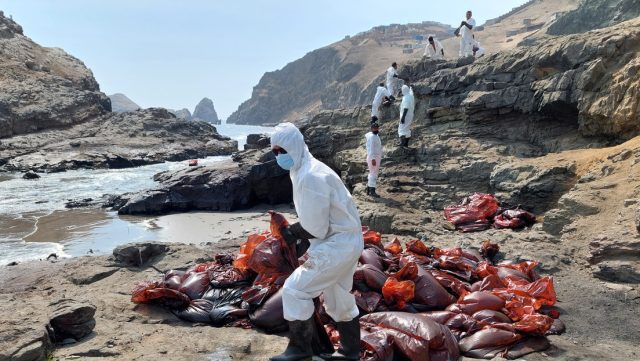While the world is surprised after the environmental disaster caused by the immense spill of 6,000 barrels of oil on the coast of Ventanilla, in the peruvian province of Callao, environmentalists warn that far from being an occasional accident, Peru registers many accidents caused by extractive activity, in the face of a repeated passive attitude of the local authorities.
Indeed, since the end of December alone, the Northern Amazon Oil Observatory reported at least four oil leaks in that emblematic jungle area, which has become a site of constant incidents. The losses that occur in the Loreto and Amazonas regions usually cause significant impacts on nature, animals and also to the indigenous communities, affected by the actions carried out on properties such as the Norperuano Pipeline, Block 192 and Block 8. For example, in this last site, an apparent damage ended with the contamination of the Huanganayacu River, just a few days ago.
According to records from the Agency for Environmental Assessment and Enforcement (OEFA), between March 26, 2020 and July 25, 2021, there were 45 oil spills in Loreto, and 45% corresponds to the firm Pluspetrol Norte. Between 2000 and 2019, there were at least 474 oil spills in the Northern Amazon, revealed the report ‘The shadow of oil’. This investigation indicated that 65% of the incidents were due to operational failures or the poor condition of the pipelines, and 28% would have been due to the alleged intervention of third parties. In addition, about 94% of the spills had Pluspetrol as the possible culprit.
Peru and impunity
The director of the Politics and Governance area of the Peruvian Society of Environmental Law (SPDA), Carol Mora Paniagua, considers that the serious Repsol spill that occurred on January 15 could be «an emblematic case» to apply exemplary sanctions. This, while the damage caused is still being measured, which for now includes dead animals and dozens of blackened beaches, informs RT.
The lawyer’s comments come against many backgrounds of spills without major consequences for the companies. And the worst, without remedying the affected area or compensating its direct victims. The problem is, that what was happening in the Amazon is a prelude to what could happen in other regions.
«For the most part, the spills are related to the poor environmental performance of some companies», says Mora Paniagua. She also highlights «the obsolescence of hydrocarbon transportation and the non-updating of environmental management instruments», added to «the lack of infrastructure maintenance, remediation and repair measures».
Beyond the circumstances in which an environmental disaster occurs, and those responsible for it, Mora Paniagua focuses on the State’s position in the face of this type of events. «In the case of the spills generated in the Norperuano Pipeline, between 2014, 2015 and 2016, which occurred very frequently, they had a scenario of impunity», she regretted . And she adds: «During that time in Peru there was a moratorium so that the environmental control authorities could not sanction the companies, supposedly as a promotion measure».
As of today, if the latest list of penalties imposed for various contractors is reviewed, corresponding to December 2021, only the words «arrears» or «other penalties» are read, without further details on the sanctions applied.
Judicial processes that take a long time
«In cases where millionaire fines have been imposed against public or private companies, they have been challenging the sanctioning measures in administrative and judicial channels», warns the lawyer. «In some way, it generates impunity and the dilation of environmental justice processes», she says. Mora Paniagua even stresses that the fines «are not even intended to repair the damage or compensate the population affected by the spill, but are intended for the National Public Treasury».
Thus, although there are laws and regulations in force, «the lack of effective environmental justice» can extend legal disputes «for years». For this reason, she insists that what happened in the coast of Ventanilla can mark «a before and after», if the corresponding fines are applied, compensation for damages, the rehabilitation of the affected areas and future prevention measures are put into force.
In any case, beyond the public statements made by the Government of Pedro Castillo and the inspection entities, from the Peruvian Society of Environmental Law they maintain that it is unknown «what is the contingency plan that Repsol had to have implemented, because of the lack of transparency of accountability”.
This is why, considering «the cause of force majeure» that would have generated the failure, such as the waves produced by the volcanic eruption in Tonga, «it is important to analyze what was done once the environmental emergency occurred». And she concludes: «Whether on the coastal coastline, or in the Amazon, we must try not to repeat mistakes».











